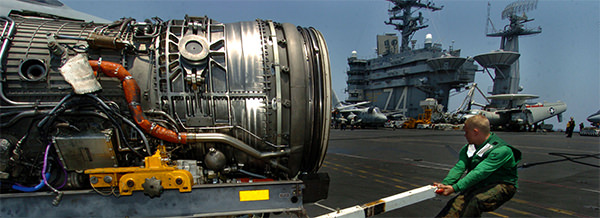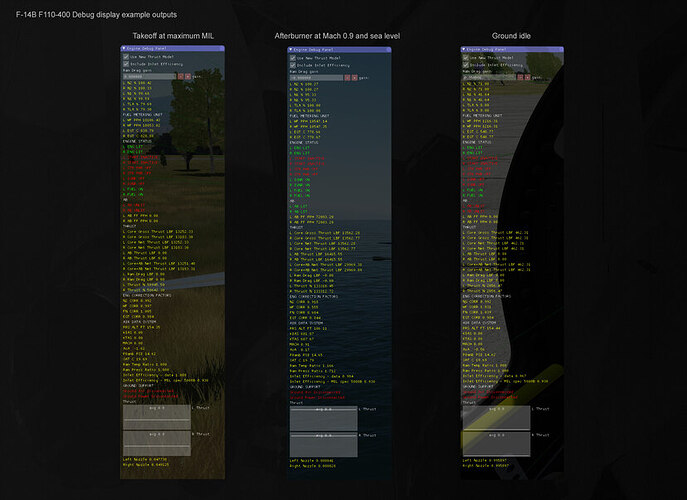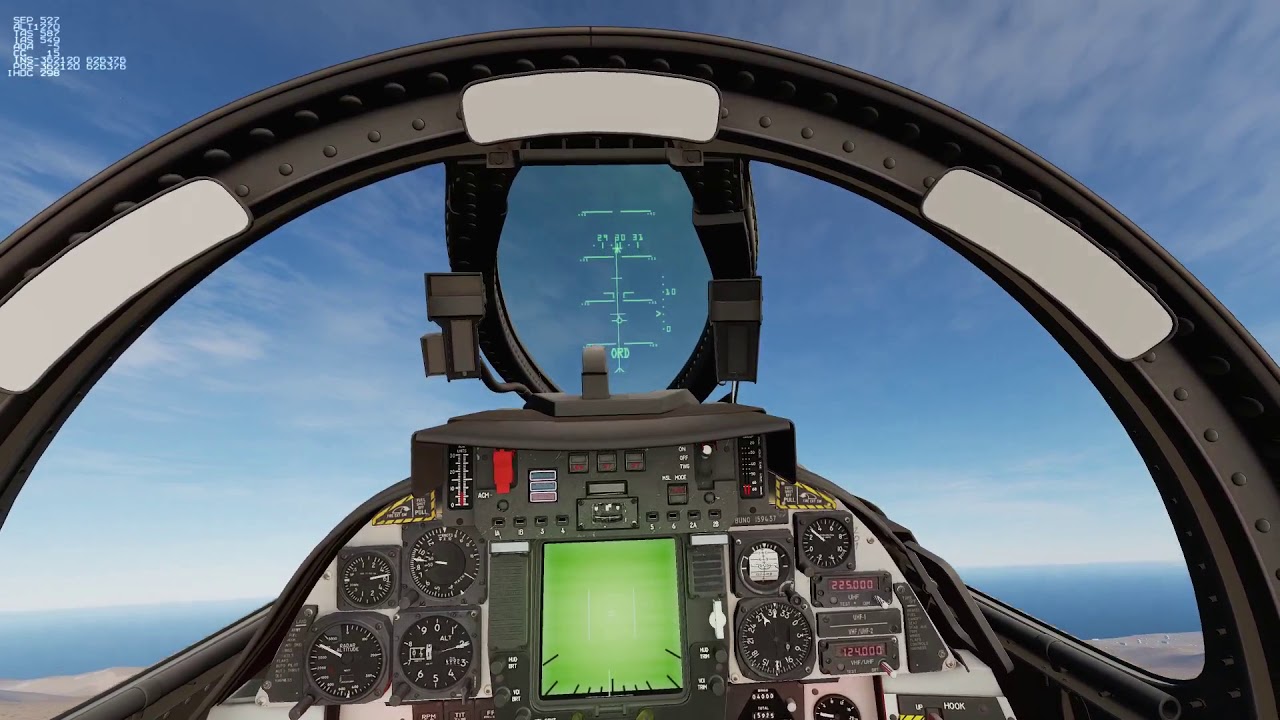So we can have f-111 2019
Can I at least get viggen mirrors?
The fun thing is you can scroll up this very thread to fact check that.
The TL;DR of this post was: we’re tweaking the systems and flight model, and we’re working hard to integrate our refactored visual model
The update closest to a year ago was last March
That post’s TL;DR was we’re finishing up the AFM, we’re beginning work on the ASM (Weapons System, through which everything eventually flows in the Tomcat), and we’re about to take a big trip to the US to look at actual Tomcats to back check our visual models
They released their first video showing their integrated AFM in August, they showed a comprehensive AWG-9/TID/DDD simulation in November. The only thing we haven’t seen consistent updates on is the visual model. They announced it would be completely reworked sometime in the summer, and is the one thing Heatblur can absolutely be relied upon to deliver.
The only guarantees in life are death and taxes, but I’m confident in 2018.
obligatory TopGun movie gifs.
Muchly looking forward to this one. It’s gonna be good ![]() :
:
I’m eagerly awaiting the F-14 as well, the only reason I brought it up is I logged in to mudspike from a new device, and it started me at the top of the thread without realizing it. As I read through the old updates they just seemed very similar to the most recent. Just kidding around of course, maybe RAZBAM spoiled me with WIP harrier videos seemingly weekly, placeholder sounds/graphics and all.
Text from the link @near_blind posted:

The Tomcat has a new powerplant model!
While we’ve already undertaken the development of an engine model with the Viggen, we decided last year to completely redesign this portion of our simulation framework, in order to create an much more in-depth and realistic simulation of a turbofan engine. This will also help us in recreating the P&W TF-30 engines for the F-14A, as well as other turbofan, turbojet, or turboshaft engines for our future product lineup.
The F-14B is powered by two F110-GE-400 turbofan engines with variable exhaust nozzles and afterburner augmentation.They are dual-rotor engines consisting of a three-stage fan driven by a two stage, low-pressure turbine and a mechanically independent, aerodynamically balanced, nine-stage high-pressure compressor driven by a single-stage, air-cooled, high-pressure turbine. Engine operation is automatically regulated and maintained electrically by the augmenter fan temperature control unit and by throttle inputs to the main engine control.
This new F110 model has been built entirely from scratch, incorporating many new features and improving the accuracy and fidelity of the engine simulation. The following components of the engine have been modeled based on actual F110 engine data gathered from various sources:
-
Air Inlet Control System (AICS)
The primary job of the AICS is to provide quality airflow to the engine in sufficient quantities to prevent engine operation issues. This involves a reduction of the speed of air entering the engine’s fan/compressor face. During this process, incoming freestream airflow is slowed and compressed. As a result, ram temperatures and pressures entering the engine are increased. On the F-14 this is achieved primarily by a system of 3 moving ramps per side that are scheduled based on flight conditions. During supersonic flight, these ramps are scheduled to move in a way that creates multiple shockwaves to more efficiently compress incoming air than a conventional duct would. The efficiency of the inlet’s pressure recovery throughout the flight envelope has been captured from real F-14 flight test data for use in the Heatblur F-14. Considerations for ramp actuator malfunctions have been made, which can include thrust loss and reduced stability margin (i.e. higher potential for compressor stall) if the ramps are out of their scheduled positions (i.e. high speed with the ramps in their stowed position…don’t do this!). -
Augmenter Fan Temperature Controller/Main Engine Control (AFTC/MEC)
The AFTC/MEC on the F-14 is similar to a FADEC (Full Authority Digital Engine Control) in function. It schedules fuel to the engine and afterburner based on numerous inputs. It also provides limiting functions to prevent engine damage and reduce risk of compressor stalls. RPM, EGT, and acceleration/deceleration are all limited by the AFTC to ensure safe engine operation. Other AFTC functions include engine start control, asymmetric thrust limiting, automatic relight, and fault detection. Fault detection automatically switches the engine control to secondary mode in the event of core overspeed, fan speed signal loss and other abnormal conditions. The AFTC/MEC simulation on the Heatblur F-14 takes in probe temperatures and pressures from the AICS, Mach number, pilot throttle positions, fan and core rpms, and engine ignition status, and outputs demanded fuel valve positions. These valve positions correspond to fuel flows that will cause the engine’s core to accelerate or decelerate as demanded by the pilot. While the pilot can demand a certain core speed, the AFTC is also constantly monitoring other engine parameters, such as N2 RPM and EGT to ensure that engine design limits are not exceeded and engine damage does not occur. Essentially, the AFTC protects the engine from the pilot while trying its best to give the pilot what he/she demands. When AFTC failures occur, the AFTC/MEC model reverts to what is known as secondary mode, in which the MEC governs N2 speed based on throttle inputs, but protection features such as EGT limiting are no longer available. Be aware that engine stall margin is decreased slightly at low rpm in this mode. -
Fuel Metering Unit (FMU)
The FMU consists of the system of valves and pumps responsible for carrying out AFTC fuel schedule demands. The AFTC outputs fuel valve position commands which in turn spray high pressure fuel into the combustor and afterburner when in use. The Heatblur F-14 model consists of a system of valves that open/close according to AFTC demands, as well as a shutoff valve for engine fires and automated shutdown commands coming from the AFTC. Failures such as stuck valves and clogged fuel filters may be implemented in the future. -
Gas Generator (N2)
The gas generator is the heart of any turbomachinery. Its primary purpose is to provide hot, high pressure air to the combustor. This is done by reducing the speed and increasing the pressure/temperature of the incoming inlet air even further, which the F110 can do at a pressure ratio of in excess of 30:1. The gas generator on the F110 is driven by a single stage high pressure turbine. The gas generator simulation in the Heatblur F-14 is robust, with the speed and acceleration of the core determined by fuel flow from the FMU, the speed of air entering the engine, and the inertia of the core itself. The amount of fuel introduced into the flow by the FMU directly corresponds to changes in torque applied to the power turbine, which in-turn changes the compressor speed as it is connected to the same spool. Failures such as compressor stalls (core airflow disturbances) may affect core speed, as well as any failures of upstream components that affect the fuel flow, such as -AFTC/MEC or FMU failures. -
Fan (N1)
The fan on the F110 is driven by a two stage turbine, with a bypass duct that is mixed back in to the core flow in the afterburner section. The bypass ratio of the F110 is about 0.85. Low-bypass ratio turbofans such as the the F110 have the benefit of improved fuel economy at cruise speeds, while still maintaining very good high speed performance. This makes them excellent engines in fighter aircraft applications. The Heatblur F-14 fan simulation is driven as a function of core speed, with a given steady state core speed corresponding to a steady state fan speed. Any failures affecting the core will also affect fan speeds. -
Combustor/Exhaust Gas Temperature Model
The combustor section of the F110 ensures that high pressure fuel flow is efficiently ignited, dramatically increasing the temperature and pressure of the gases before the flow is expanded through power turbine section. The Heatblur F-14 combustor/EGT simulation is dependent on the amount of fuel being introduced into the engine, which is determined by the AFTC/MEC and FMU models. -
Afterburner
The afterburner on the F110 provides extra thrust by introducing additional fuel into the flow after the power turbine section. Fuel flow to the afterburner is controlled by the AFTC and AB Fuel Control (AFC), with its own set of high pressure fuel pumps that cycle fuel back to the engine boost pumps when afterburner is not in use. This ensures that high pressure AB fuel is available at all times to prevent thrust lags and surges when AB is initiated. The Heatblur F-14 afterburner simulation is purely dependent on available AB fuel flow and throttle position, with the extra thrust as a function of AB fuel flow and nozzle position. Failures to the AFTC/MEC, AB fuel pump failures, or exhaust nozzle failures will affect AB operation and performance. AB operation is inhibited when in AFTC/MEC secondary mode. -
Starting System
The engine start system is a turbine powered either by a ground air/power cart or via a crossbleed start from the opposite engine. Ground power can achieve approximately 30% N2 before light-off. In our F-14 starter simulation, the ENG CRANK switches open pneumatic valves allowing the ground cart air to begin spool-up of the core. As the core spins up, the MEC primes the engine with fuel and provides ignition and fuel control up to 59% N2 RPM. -
Variable Exhaust Nozzle
The variable exhaust nozzle is responsible for controlling the expansion of exhaust flow downstream of the afterburner section. Engine exhaust gases at higher thrust settings are discharged through the nozzle throat at sonic velocity and are accelerated to supersonic velocity by the controlled expansion of the gases. Varying nozzle throat area controls fan stall margin, which optimizes performance. The Heatblur F-14’s nozzle simulation is dependent on Mach number, altitude, throttle position, weight on wheels, engine oil pressure, and AB operation status. Failures in the nozzle will affect engine thrust and stability.
We’re still working on completing our engine simulation. In particular some of the remaining items to be completed pre and post early access include the:
- Engine Oil System
- Bleed Air Draw Effects
- Generator Load Effects
- AICS Anti-Ice and Icing Effects
- AFTC/MEC Secondary Mode Effects
- Reduced Arrestment Thrust System (RATS)
- Asymmetric Thrust Limiting
- Afterburner Ignition System
- Throttle Control Modes (Approach Power Compensator already complete)
- Windmill and Cross-start failures and effects
- Battle Damage Effects
- FOD Effects
This new engine modeling will serve as a robust and deep base for all of our future jet aircraft simulation. An accurate recreation of the aircraft’s powerplant and all of the follow on effects is important, as it allows us to more accurately depict common F-14 flight characteristics, failure states and especially dangerous situations arising from engine related issues. These effects will become even more apparent as we simulate the TF-30 engines as found in the F-14A. Be gentle with those throttles!
Below are a couple of exports from our engine diagnostic interface. The descriptions above each column describe the conditions in which the snapshot of data was taken in.
Thanks for reading!
Heatblur Simulations F-14 Team
Nicholas Dackard
Director | Lead Artist
Heatblur Simulations
![]()
What caught my ear was that the extra assets to support the Tomcat are the Forrestal, accompanying ships and some unannounced surprises (which therefore are not ships). Possible assets to accompany the Tomcat that are not ships?
Friends: AI A-7E, AI A-6E (to be developed into next full module by HB?) AI KA-6D tanker.
Foes: AI Tu-16 Badger missile strike, maritime recon and ECM escort variants, AI Tu-95RT Bear-D long range maritime recon.
How about a friend for Jester:
![]()
I just spent a month writing a script to generate bomber raids w/ proceeding recon. If this were the case…

Nice video, even though it feels like this was not intended for the general public.
and yet the dev who made it posted it to the general public. I’d much happier to see progress communicated than fret about production quality.
I’m not fretting about the quality, why would you even say that?
I made a remark, because anything Heatblur have posted in video form as of late was highly polished. Personally, i don’t mind tech demo videos. It just appears that this one may have found its way to the public without the creator’s intention. After all, it is unlisted, which doesn’t support that the dev “posted it to the general public”.
It was posted on reddit. One dev shared it, a second acknowledged it, and it has not been removed. I wouldn’t share things I thought weren’t intended to be shared.
Thanks for clearing that up, then…
Is the RIO involved in this process?

